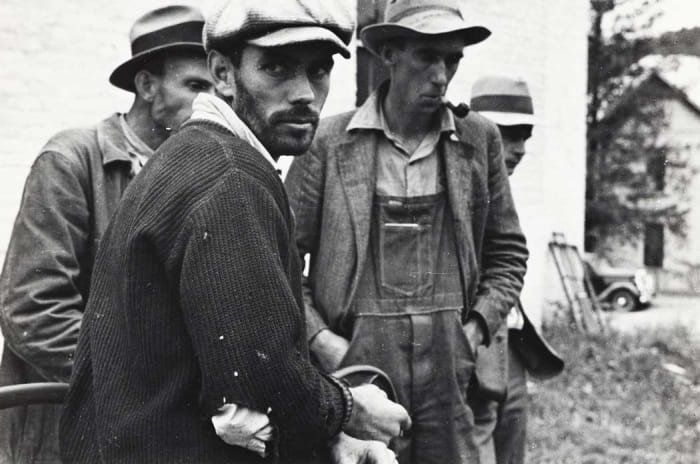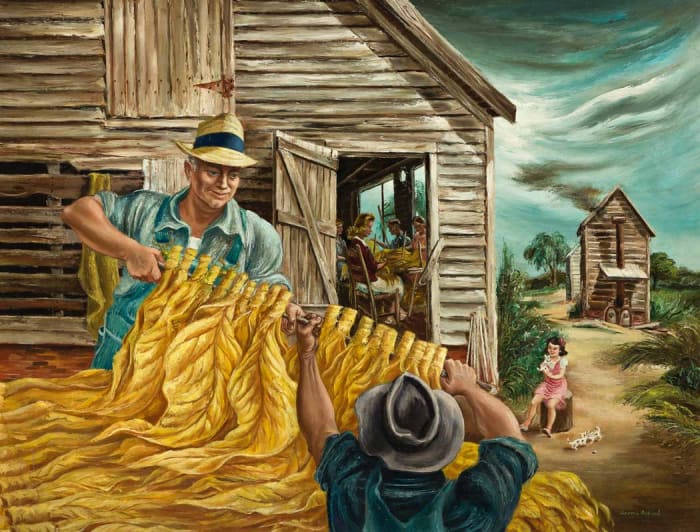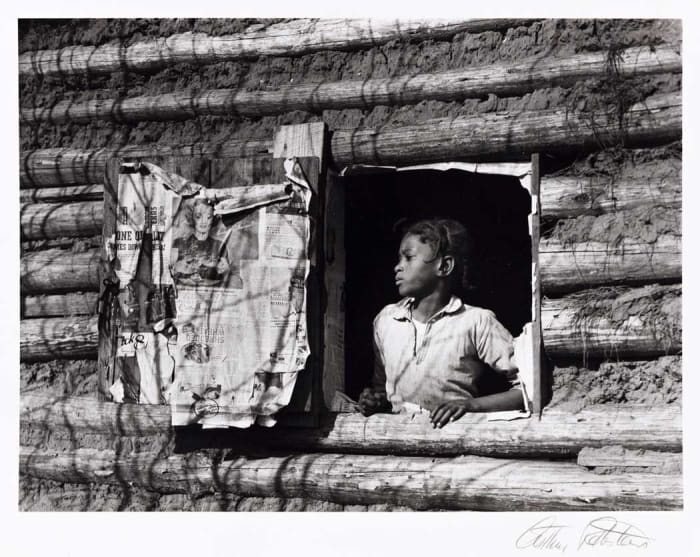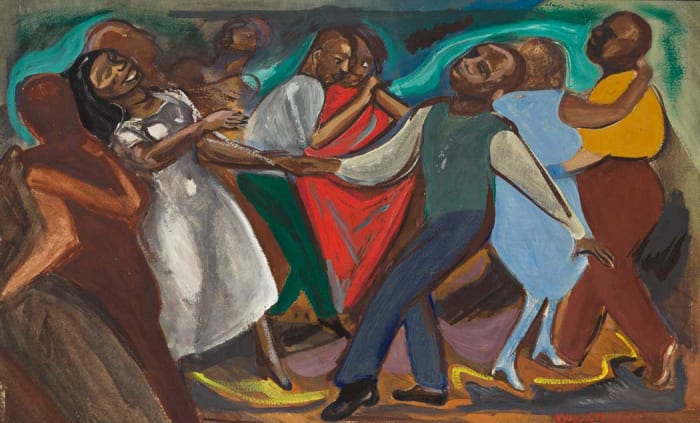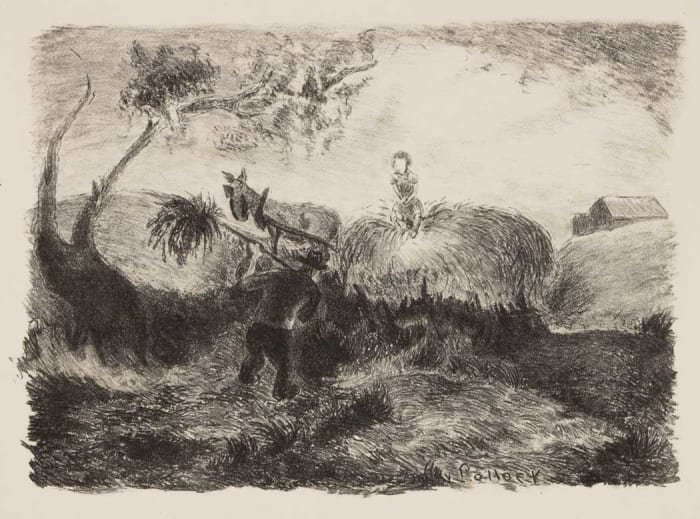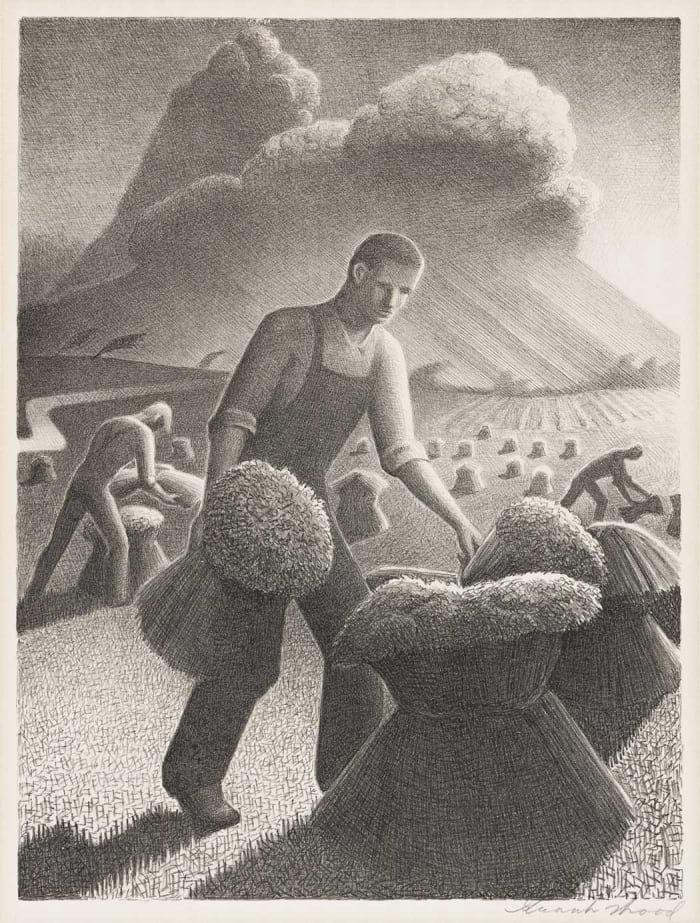The stock market crash in October of 1929 set off a severe economic shockwave in the United States, one that washed over financial systems and citizens with no social safety net for support.
In the presidential election of 1932, Franklin Delano Roosevelt defeated Herbert Hoover in a landslide victory. FDR’s vision of a New Deal to usher in changes was set in motion, with goals of strengthening our financial systems, and programs designed to employ the masses and develop infrastructure.
The New Deal had a wide array of work programs. One such program, the Work Project Administration’s Federal Art Project changed the course of art in the U.S. From 1935 to 1943, WPA artists – painters, photographers, printmakers, illustrators and more – from diverse backgrounds worked in a wide range of styles and subject matters. The dominant theme and the major focus of artists in those challenging years was social realism.
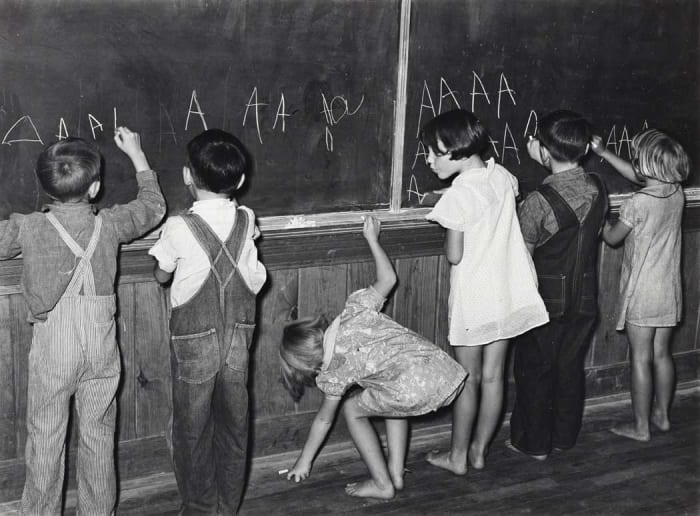
Russell Lee, Children at the Blackboard, Lake Dick Project, Arkansas, 1938, photograph.
Courtesy Swann Auction Galleries
On January 27, Swann Auction Galleries offers Artists of The WPA, exploring the themes, motivations and artists that defined the New Deal era as part of the many agencies that formed during that period. Capturing vernacular architecture to the rise of the modern city, the elevation of visual and performing arts, interior scenes of domestic laborers to pool halls — allowed artists to paint, print, and photograph during a period of great strife as a means to forge forward.
As many as 10,000 WPA artists helped form a modern American identity, capturing life in all its variety, one rooted in pride and tenacity. These images provided identity and narrative to the victims of the Dust Bowl and Great Depression, allowing a nation to better relate to fellow Americans hit significant forms of hardship.
The following is a selection of WPA art from the Swann event with input from Harold Porcher, director of Modern and Post-War Art at Swann.
Maynardville, Tennessee
Artists of the Federal Arts Project documented a new way of life—a modern America that offered representation of what the nation looked like and how your neighbors lived. Ennobling images were taken to document the grit and tenacity of the American spirit.
Getting Ready for Auction
In 1941 the president of American Tobacco Company approached then director of the New York gallery, Associated American Artists, Reeves Lewenthal to select leading American scene painters to travel to the American southeast to capture in paintings the planting, harvesting, curing and auction of tobacco crops. Amongst the nineteen artists who received the commissions for this project were Arnold Blanch, Aaron Bohrod, and Ernest Fiene. These paintings appeared in adds for Lucky Strike brand cigarettes from 1942 – 1947. In the 1940s more than 1.5 million American farms were dedicated to supplying the tobacco industry.
Girl at Gee’s Bend, Alabama
“Girl at Gee’s Bend, Alabama, is a striking half-portrait of Artelia Bendolph staring out into an unknown distance. The window on the Kutcha house is insulated with old news clippings of domesticity. In February 1937, the Farm Security Administration assigned Arthur Rothstein to photograph Gee’s Bend, a former plantation that had become an isolated African American sharecropping community. Rothstein’s image emphasizes the difficult yet sometimes picturesque living conditions rather than any signs of progress. Gee’s Bend is now famous for the sophisticated artistry of its quilting tradition.” Corey Serrant, Administrator, African American Art, Swann Auction Galleries.
Pelham Bay
This painting, of a Pelham line train (#6) full of passengers, illustrates the importance of a strong infrastructure with affordable housing and transportation—it was made circa 1935 in the middle of the American depression.
Harlem Street Dance
Elizabeth Olds (1896–1991) was an American artist known for her work in developing silkscreen as a fine arts medium. She was a painter and illustrator, but is primarily known as a printmaker, using silkscreen, woodcut, lithography processes. In 1926, she became the first female honored with the Guggenheim Fellowship. She studied under George Luks, was a Social Realist, and worked for the Public Works of Art Project and Federal Art Project during the Great Depression. In her later career, Olds wrote and illustrated six children’s books.
Jackson Pollock was an influential American painter, and the leading force behind the abstract expressionist movement in the art world. His “Stacking Hay” reveals an early moment in Pollock’s career under his painting teacher, Thomas Hart Benton, who he studied under from 1930 to 1933. Benton’s influence is clear, yet “Stacking Hay” also hints to the dynamism Pollock himself would develop over his own time in the WPA, being exposed to the murals and styles that would become his drip and action painting of the 1940s.
Wood was one of the most well-known muralists of the WPA, rising to celebrity status after his painting “American Gothic” won a bronze medal at the Art Institute of Chicago. Wood had always wished to re-create the midwest as an arts center and helped to found an artist colony in his native Cedar Rapids in 1932.
In the Iowa University Parks Library in Ames, Iowa, Wood produced a series of murals in his archetypal American regionalist style (a first set for the Public Works of Art Project in 1934, a second in 1936 under the WPA). Wood also was involved in the production of another Iowan mural project at the Callanan Middle School in Des Moines for the Federal Arts Project.
You May Also Like:
Artists at Work: The WPA’s Influence on American Art


